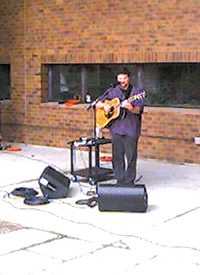Aesthetic Appeals: Art Talks with Margaret Wagner
February 27, 2002
Science and art don’t mix right? Like searching for the philosopher’s stone, most people would think twice before combining the subject matter. What would the bastard children of this unholy union produce? Avant garde DNA spirals made of plaster and fiberglass? Macramé beakers and test tubes? A new gain in groundbreaking boredom? Not likely.
Meet Margaret Wagner, an assistant professor of art (digital imaging) at UMass Boston and one of the speakers in a five-part series of informal lectures currently being held in the Harbor Art Gallery. The “Art Talks,” so called because they explore the viewing of art on different levels, will be running on alternating Tuesdays and Thursdays. Wagner successfully manages to integrate two completely different subjects into projects partly based on personal narrative and her own fascination with women’s health.
I went to the Talk unsure of what to expect. I was not enthused by the prospect of dealing with more installation art, in spite of some of the recent pleasant experiences. People are slow to change their views and I, unfortunately, find incomprehensible a majority of contemporary work out there with the exception of a few. However, I was curious to see how she would handle two opposing disciplines. I was not disappointed.
Using modern technology she explores the inner sanctums of women’s bodies. Through imaging, MRI’s, and echocardiograms, she takes us on a journey through the process of discovering women’s health and how the matter is treated by the medical community. Drawing upon her own memories of her mother’s bout with cancer, Wagner humanizes an otherwise seemingly unrelated and bizarre series of images she ascribes names like “Base Pair Recognition.”
As I sat viewing Wagner’s past works and projects-in-progress, I was fascinated by the way she placed a series of randomly appearing symbols together. Although it would seem somewhat meaningless to a viewer, once she explained a majority of the feelings and associations behind them, I understood perfectly where her ideas were going. For once, I didn’t regret my stint as a biochemistry major and high school lab rat.
One slide that caught my eye pictured a piece called “MisTranslation XOXO” displaying the two letters mounted separately, side-by-side. It could remind people of many different things: the universal symbol of “hugs and kisses,” binary code, tic-tac-toe, and much more. Yet it wasn’t the art that had me so enthralled.
Wagner’s way of lecturing is reminiscent of Stephen Hawking’s tone in A Brief History of Time. Her manner of speaking implies that of a scientist-philosopher, an alchemist for our time, in referencing the Human Genome Project one minute and detailing her familial experiences (“a child and lab rat, experimenting and being experimented upon”).
In another of her slides and her extensive resume, she includes a series of fiberglass fish, and historical, topographical, and regular maps on three panels for a site-specific installation at the 1999 Horsehead sculpture exhibit. The exhibit, appropriately entitled, “Fish Out of Water,” showed a school of salmon traveling up the side of a hill with the natural history imposed in looking through pseudo-park information panels.
Wagner takes an approach that is both biological and biographical while still being approachable. Her works’ naturalistic undertones and awareness of life rhythms are truly a unique segue into the psyche of science and a single woman’s work in art.





















































